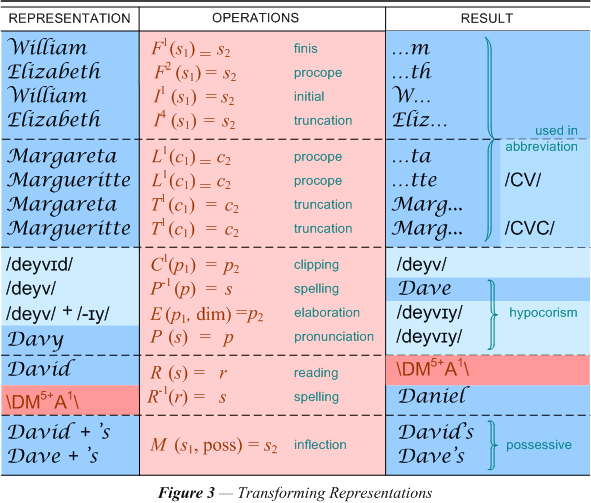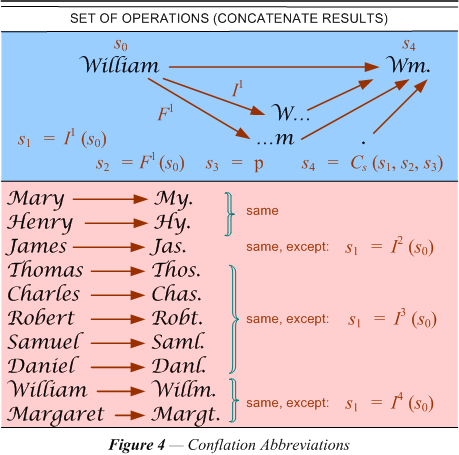
Abbreviation. There are several ways that a clerk used to treat names, so as to reduce the length required to record them. These are functions acting on character strings usually designed so as to extract the most distinctive portions of the name. In almost every case the first part of the string seems to have been the most important. The most extreme example was when a name was reduced to a single initial. A close second in importance was the ending or coda. Cutting off the coda, or the last part, is truncation, whereas removal of the front is procope. Syncope names the process that combines these two processes. We find similar processes at work in the two hidden dimensions of the grapheme and as parts of other kinds of variation. Figure 3 displays some of the various possibilities for using these basic processes to describe such variation.

The different degrees of truncation and procope may be measured in terms of the length of the name spelling. As an example we may take the formerly very common method of abbreviation which we will call conflation. This method is a special kind of syncope whereby the clerk selects an appropriate proportion of the name (usually from one to four characters) to take from the front and attaches the final character of the name to these. Often this final character is raised above the line of writing. In transcription the fact that the form is an abbreviation is usually indicated with a final period. Figure 4 illustrates that there are various lengths left after truncation, depending on which name is being abbreviated.

Suppose that William is the name to be abbreviated. It is the input string to a conflation function, Ac(William, 1) to which the second parameter indicates the length of the initial string to be retained. The function takes this information and analyzes the input string into two strings. The first string consists of as many characters from the front as indicated by the length parameter. These are obtained as the output of the function I(William, 1) where one (1) is the length. Secondly comes the final character, which is identified as the output of the function F(William, 1). Both of these results are then concatenated together with the period “.” — a character constant. Similarly the function Ac(William, 4) will yield Willm.
Figure 5 takes the description of conflation further by formalizing the process using a rewrite rule. This rule takes as input a single string, analyzes it as the concatenation (Cs) of three strings, and then outputs the concatenation of two of those elementary strings together with a period (p), which is signified as a character constant. The single forward slash indicates certain kinds of conditions on the context. In this case the input string must be preceded and followed by morpheme boundaries, #. There is also an additional condition that the length of the initial portion of the name, which is retained, consist in four characters. We will call this rule “Ac4” for “conflation abbreviation retaining four characters.” An important measure on such rules is the degree to which the name spelling is shortened thereby; here four of the nine characters or 44%. A second conflation abbreviation illustrated involves a different string constant. In this case the Greek letter chi (X) abbreviates the first five characters of any of several given names beginning with the name Christ. The information loss occurring with abbreviation has the consequence of raising the possibility of confusion or ambiguity resulting in uncertainty about the original form of the name represented. We will have more to say on this below.

